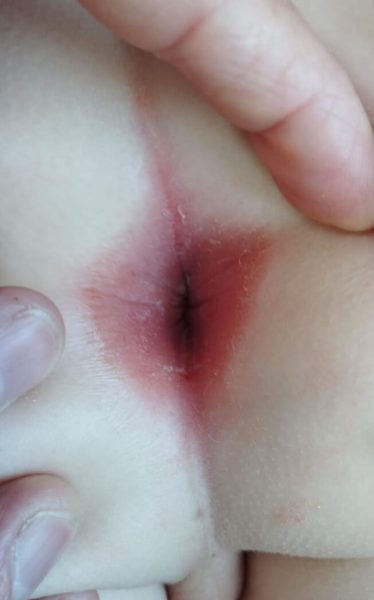
Perianal dermatitis in children
There are several reasons why this is a good topic to discuss:
1. To get familiar with this condition and learn how to treat it.
2. To briefly learn about the infectious pathogens that cause perianal dermatitis including group A streptococcus.
3. To get familiar with the condition to avoid unnecessary thoughts about worms and unnecessary treatment.
In fact, this third reason is the main reason I decided to write this post.
What is perianal dermatitis?
Dermatitis is a skin irritation.
Peri– around
Anal– the anus
Perianal dermatitis – irritation in the skin around the anus. See the image attached.
How common is this?
Obviously, this is very common. Especially in children as this area tends to be more dirty.
Bacteria and fungi love the type of environment present around this area.
Children scratch this area often and cause injury to the skin.
In short, it gets quite messy!
What are the specific pathogens (bacteria and fungi) that cause perianal dermatitis?
Look. There doesn’t have to be bacterial or fungal involvement in order to cause redness and irritation to the skin. It’s enough for a little bit of stool to sit there or some sand from a sandbox to get in there. Plus, a child that is scratching that area.
You then get bacteria on that irritated skin, typically stool bacteria (gram negative bacteria) – all the different kinds.
Candida can also replicate in this area, but this is seen mostly in infants experiencing diaper rash and less so in older children.
And also, group A streptococcus.
Can Group A Streptococcus infect perianal dermatitis?
Indeed, group A Streptococcus.
What are the signs of this type of perianal dermatitis?
Mainly discomfort and pruritis, all throughout the day.
On examination, we see localized redness and dryness.
So how is this associated with worms?
The only association to worms is that children who suffer from worms (Enterobiasis) tend to wake up in the middle of the night and scratch this area.
But, there are three main buts:
1. The itch in children with dermatitis in this area occurs all throughout the day, and not so much at night.
2. In perianal dermatitis the perianal region is red and irritated. Not always as severe as the picture attached but it is quite irritation.
3. There are no worms wandering about.
So, I don’t always have to treat my child with Mebendazole when they are experiencing an itchy bum?
No.
First of all, I suggest you read the important post I have about worms on this website.
Second of all, if the itchiness occurs during the day or evening, it is more likely to be caused by perianal dermatitis and then the treatment is completely different.
How is perianal dermatitis managed?
The treatment includes a soothing ointment. Keep in mind that we may have 3 different components to an ointment:
An antibiotic component – this is always important to have because the condition is associated with bacteria.
A steroidal component – this always helps with dermatitis.
An anti-fungal component – in my opinion this is unnecessary for this condition.
This is why I assume that almost every ointment that contains antibiotics that you may have at home, will help, and even more so if it contains steroids.
How is this condition diagnosed and how do we treated perianal dermatitis caused by group A Streptococcus?
Its not always possible to differentiate between the different types of dermatitis, but this type of dermatitis is typically very red and round.
You can use a rapid throat swab to test for group A strep in this area (just by rolling the swab over the red area).
The treatment does not differ from any other perianal dermatitis. Antibiotic ointment.
I have never treated perianal dermatitis, regardless of whether the cause is group A strep or not, with oral antibiotics. I know that there are physicians that would recommend amoxicillin for several days. I think this is unnecessary. It is always resolvable with good hygiene and topical antibiotics.
In addition to topical treatment, how else can we get rid of this?
Hygiene.
Keep the area clean and free of stool after wiping.
Changing underwear frequently.
Cleaning the area and gently drying it afterwards.
Cutting the child’s nails.
And if it does not seem to improve or seems to worsen – consult with your primary care physician.
In summary, this is a common topic in pediatrics and I have two main take home messages for you:
1. Try not to imagine worms
2. Treat the cause.
Good luck!
For comments and questions, please register
